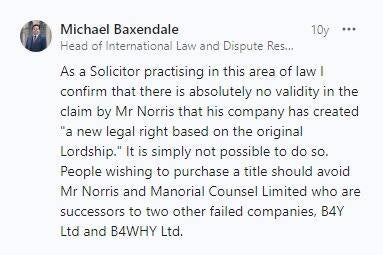Wikipedia Barony North Cadbury
These are the details on Wikipedia for the Barony of North Cadbury. Wikipedia should only be detailing those titles which have a complete set of deeds. Not the misleading titles that manorial Counsel's solicitors register. Which are of 'Quiet Enjoyment' only. Manorial Counsel's solicitors have mislead Wikipedia and mislead The Gazette.
Feudal barony of North Cadbury
[edit]
In the Domesday Book of 1086 the manor is recorded as held as part of the extensive fiefdom of Turstin FitzRolf, the supposed standard-bearer to William the Conqueror at the Battle of Hastings in 1066.[5] The lands held by Turstin were subsequently proved to have been held under the feudal tenure per baroniam, making the holder a feudal baron. The caput of this barony is stated by Professor Ivor Sanders (1960)[6] to have been North Cadbury, although Turstin's central area of operation seems to have been around Caerleon Castle on the English border with Glamorgan, South Wales.
Turstin seems to have been banished in about 1088, possibly having opposed King William II of England in his struggle for the English crown with his elder brother Robert Curthose, Duke of Normandy. The fiefdom then passed to Wynebald de Ballon, newly arrived with his brother Hamelin de Ballon from Maine, France. Wynebald was a close associate of King William Rufus, and probably received Turstin's fiefdom as a reward for services unknown. Wynebald's centre of operation was at Caerleon Castle, on the River Usk, higher up which was founder Abergavenny Castle by his brother Hamelin. Even further up the river Usk was situated the caput of the great Marcher Lordship of Bernard de Newmarch at Brecon. Wynebald de Ballon's 2 sons died without issue and his heir to the barony became his daughter Mabilia, the wife of a certain "Henry de Newmarch". No evidence has survived as to the ancestry of Henry de Newmarch, but circumstantial evidence suggests that he was descended from Bernard de Newmarch, Marcher Lord of Brecon, by a first marriage. Bernard's sole heiress was certainly his only daughter by his last marriage to Sibila. Bernard is said to have had children by a first marriage, as mention of them is made in a charter to the monks of Brecon, in which he speaks of sons and daughters, especially devising the lands of Costinio for the welfare of the soul of his son Philip.[7]
The barony of Wynebald, which can at this stage in its history be termed the "barony of North Cadbury", descended into the family of his son-in-law Henry de Newmarch (d.1198). Henry had 2 sons, Henry (or possibly William) the eldest who died without issue in 1204, and James (d.1216) who according to Wiffen (1883)[8] married Maud, later the wife of Otto FitzWilliam. James had no son but left 2 co-heiresses, Isabel and Hawise, who being heirs of a tenant-in-chief became wards of the king. The king (either King John just before his death in 1216, or more likely the council of his infant son King Henry III (1216–1272)) granted the wardship, which included the marriage also, of Isabel the elder daughter to John Russell (d.1224) of Kingston Russell, Dorset. Russell had been a household knight of Kings Richard I (1189–1199) and of his brother King John (1199–1216) and of the latter's infant son Henry III, the latter whom he also later served as household steward. The wardship of Hawise the younger the king granted to John de Boterel, confirmed to the latter by Henry III in 1218, per the Close Rolls. Russell was by then elderly and already married with a family so he married-off Isabel to his eldest surviving son Ralph Russell, which action raised Ralph to the status of a feudal baron and gave him possession of a moiety of the lands comprising the barony of North Cadbury. John de Boterel was clearly then unmarried and perhaps younger for he exercised his grant by marrying Hawise himself; however he was not to live much longer and following his death without issue Hawise married secondly in about 1230 Nicholas de Moels. The descendants of both daughters retained all or some of the North Cadbury baronial lands they inherited until the 16th century, when the Russell moiety was then held by the Denys family of Siston, Gloucestershire. On the death of Thomas Russell in 1431, the 21-year-old son of Maurice Russell, knight (d.1416) of Dyrham, Gloucestershire, the heirs to the Russell lands became Thomas's elder half-sisters Margaret, whose first husband had been Gilbert Denys, knight (d.1422), upon the issue of which marriage her inheritance had been settled, and Isabel, then wife of Stephen Hatfield, her 4th husband. The de Moels share passed successively by marriage to the Barons Botreaux (1337), (who may by coincidence have been from the same family as Hawise's first husband John de Botrel), Barons Hungerford (1462) and the Barons Hastings in 1468.[3]
In 2011, Jörg Hubert Dumke and his wife Regina became the rightful successors and owners of the Barony and 6th Baron and Baroness of North Cadbury. The hereditary barony title is enshrined in English law as an incorporeal hereditament. The feudal Barony title of North Cadbury has been re-established by legal process by a leading authority in the UK. The legal rights to the title have been transferred by Deed of Conveyance in compliance with the Honours (Prevention of Abuses) Act 1925 (Hatton Solicitors).[9][10]
Wiki should not be entertaining detailing this entry dated 'in 2011' The German holders only have a title of 'Quiet Enjoyment' and most certainly do not have a complete set of deeds. Therefore Wiki have been mislead by Hattons Solicitors as the Germans are not the legal holders of the title. They are simply using the title name and nothing more than that.
PLEASE HELP BY WARNING WIKIPEDIA AND THE GAZETTE OF THESE ILLEGAL ENTRIES. SHARE THIS PAGE AS MUCH AS YOU CAN.

Create Your Own Website With Webador